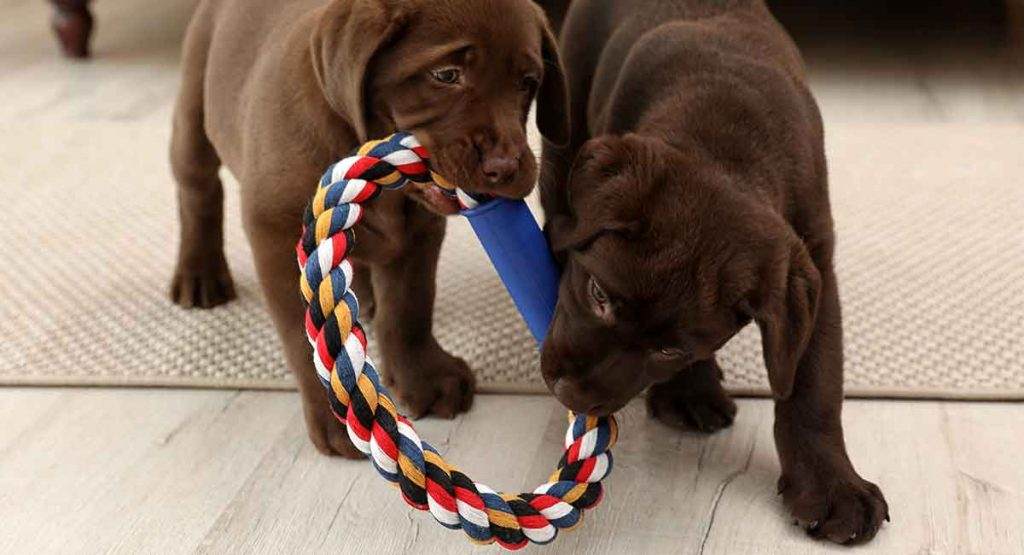When you want to teach your dog to go to bed then you can use the recommended tools like your dog’s favorite toys, “Go to your bed” command. Also, you should be ready to ignore his whining and you should also invite your puppy to the bed.
A Dog is naturally a pack animal. When you adopt a dog, you and your family members become members of their pack. A prevalent habit of pack animals is that they all sleep together for bonding and protection purposes.
Understanding this makes sense that your canine friend wants to be as close to you and your family members as possible during the night. While some dog owners enjoy this closeness, others don’t like sharing their precious pillow area with their pets.
For some dog owners, allergies forbid this kind of arrangement. For others, the thought of dog dander, hair, or at times fleas is enough to cause nightmares. Make sure to give a look to the article that I have already written on dog grooming which covers taking care of paws, eyes, ears, fur and teeth.
Some pets are too big to share your bed space, and some are pretty annoying because they always stretch out on your bed, pushing you near the edge of the bed. Some people want their bed as a sacred place where they can move, stretch out, and get up during night time.
Regardless of your reasons for restricting the sleeping arrangements of your dog, you can assist them in understanding where the right sleeping area is. You might want to begin with crate training and utilize the crate as the first bed of your dog.
If you wish, you can also provide your dog with some bedding to use in your bedroom or any other room of your home.
Why is it Important?
Although most people think that dogs can curl up and also sleep almost anywhere, your canine friend should not be sleeping on your floor. Most probably you don’t want it climbing up on your sofas or beds. The truth is, a dog needs a bed just like humans do, and they are incredibly beneficial for several reasons. Below are a few of those reasons:
Your dog will have a place of their own
In the same way, small puppies feel pretty safe and at home while in their cages, a dog bed is simply a place where the adult dogs can be the masters of their domain.
In general, the rest of the home belongs to the people living in it, and a dog can feel like a second-class citizen. But if it owns a bed, though, it will offer him a place where it can retreat to whenever it needs time alone.
Moreover, giving your dog a sleeping place will keep it from sleeping or curling up where you don’t want it to. Dogs often try to get as comfortable a spot to sleep as possible, and most of the time end up lying in your bed with you, tracking dirt on your nice carpets, or scratching up your expensive furniture.
A dog bed that suits the sleeping needs of your pet will keep it from bothering you or even damaging things in your house as it tries to sleep. To ensure that your dog utilizes it, though, make sure you get the appropriate bed. Large breeds will require big beds, and different dog beds often come with a variety of features.
Cleanliness
As much as you regularly sweep and vacuum all the floors in your house, it still is not the cleanest area for your dog to sleep. Giving your furry friend a suitable dog bed will assist in keeping him clean at all times. If your dog tracks dirt and mud from outdoors onto his sleeping place, don’t worry.
Most of the dog beds come with some removable liners or many other features that make them pretty easy to clean. That is incredibly easier than cleaning all your furniture with a vacuum or hand roller.

Health
Taking a nap on the floor or any other hard surfaces can pose risks to the health of your dog. An orthopedic dog bed can be used to assist in easing the discomfort and pain of arthritis, hip dysplasia, or any other structural illnesses.
Senior dogs should be given orthopedic dog beds because they’re far more susceptible to these conditions. Moreover, a dog bed often features other health-promoting factors, like cedar chips, which might assist in keeping odors down.
Eliminates the risks of catching an illness or disease
If your dog steps in, eats or plays with feces, it can transmit dog-to-human parasites or bacteria like earthworms or salmonella. Most puppies step in all types of things, so the probability of your canine companion carrying bacteria you might not want all over your beddings is high.
Besides, if you have asthma or any other allergies, having a dog’s fur in your bed might make all these issues worse. But keeping your pet in its bed or sleeping space will benefit not only your puppy but also your ability to get some good sleep as well.
It keeps all your other pets safe and happy
If your home has several pets, like another dog or even cats, keeping your furry friend out of your bed will set a good example for the other pets as well. Having separate beds for your pets will also enable you to get some good sleep without worrying about rolling over and maybe crushing your puppy.
How to teach your dogs to go to bed
Teaching your furry friend to go to its bed, and remain there, on command can be a pretty useful skill. Tell it “place” or “go to bed” and watch as it goes to its bed space, lies down, and also stays there.
Training this skill is incredibly simple but needs some ample time to practice. To get started, gather some delicious treats, your dog’s bed, and your dog.

#1 Put his favorite toys close to the bed
Doing this should make your dog bed more appealing to the pet. You can also put a shirt that smells like you on its bed to encourage it to lay down on its bed.
#2 Keep your puppy on its leash and lead it to the bed
You can hold out a delicious treat to give your dog some encouragement to go over to its bed. That will teach it to connect the bed with positive rewards. Don’t pick up your pup and place it in its bed or the dog will link being there with a pretty negative experience.
#3 Lure it on to the bed and tell him to stay in a down position
Don’t add a word to this behavior at this phase of training. Reward your dog by dropping a tasty treat between its paws on the pet bed. If it remains in the down position, continue dropping treats between its paws.
Release it with “free” or “ok” after a couple of seconds. Encourage the dog to get off its bed once you release it if it doesn’t know a release word already.
#4 Command it to “Go to your bed.”
Here, you should be pretty clear with the command. Give your dog a treat only when it lies down on its bed. Each time it gets up from the bed, gently say “No” and then calmly walk it back to the bed. Then, repeat your command, “Go to your bed.”
You can increase the time after you use the command and then offer it a reward only if it lies down in its bed. In the long run, the dog will learn the command and also understand that it will get rewarded if it remains in its bed.
#5 Next, stand close to the bed in the same way you did when luring the dog
This time, Do not lure the puppy, wait to see if it offers to get on its bed, if so, then reward. If it gets on the bed and lies down without your prompt, reward heavily.
However, if you wait for over 30 seconds and your puppy has not made any movements to get on its bed, then go back to luring several more times.
#6 Add distance and duration
You can only add one at a time regardless of which you begin with provided you take it pretty slow. If your dog successfully stayed on its bed for ten seconds yesterday, you can try fifteen seconds today, not twenty.
If your dog rises during this step, either when adding distance or duration, go back to the dog, cue it to “place,” and then try again. You can try working up a position where you can send your furry friend to its sleeping area from the other side of your house and having it stay for a while as you eat dinner.
#7 Ignore his whining during night time
Your dog might give you some big sad eyes every time you try going to sleep, or even vocalize its displeasure at its new sleeping arrangements by moaning or whining during the night. But you should avoid giving in to such displays because it will only reinforce its behavior and prevent it from getting used to its bed.
#8 Utilize positive reinforcement to rectify your dog’s behavior
Most pet owners utilize a water spray bottle to punish some bad behavior in their dogs, including sleeping on furniture or their bed. But positive reinforcement, whereby you reward your pup for good behavior instead of punishing it for bad habits, can also be an effective method to train your dog.
Always praise your pup if it goes to its bed without leading it or if it lies down on its bed after hearing the command “Go to bed.” That will help it connect the bed with praise and rewards instead of punishment or any negative feelings.
#9 Always invite your puppy to the bed
You should never allow your furry friend to crawl into your bed or to enter your room uninvited. That will give it a sense that it’s in charge of bedtime. Ensure that it only acts on your command, and once you wake up, ensure that it calmly waits for your command before it can get out of its bed.
Do’s and Don’ts
DO’s
- Do select a bed appropriately-sized for your canine friend. It should be big enough for it to sit, turn around, stand and lie down pretty comfortably.
- Do make the bed inviting and comfortable by placing some soft, and washable beddings inside.
- Do place your dog’s bed in the quietest place of one of the most used rooms in your house so that your pet does not associate the bed with feeling banished or isolated.
- Do introduce your puppy to the bed gradually. At first, get it comfortable going in and out on its own by tossing several toys or treats inside, without closing it in, especially if you are using a crate for bed training.
DON’Ts
- Don’t force your puppy into the bed, ever.
- Don’t rush when introducing the bed or crate. While bed or crate training might work well with many dogs, the past experiences your dog had with confinement will significantly affect the pace of your introduction process.
- Don’t allow your dog out of the bed when it is whining, or you’ll teach him that making noise gets it out of bed.
- Don’t punish or scold your dog while it is in his bed. Keep its experiences in the bed positive.
Troubleshooting
If your furry friend fails three or more times in a row, then you probably increased the duration or distance too fast. Take one step back and then try again at a level at which you know the dog can succeed.
Build up the duration or distance again more gradually this time. Do not forget your release word. Also, Any duration behavior should have an ending. Or else your puppy will learn that it can move anytime it pleases.
Reward randomly: Once the dog understands the behavior, you do not have to reward it every time. Nevertheless, if you stop rewarding completely, your dog might decide it’s not worth it any longer for it to get on its bed whenever you ask.
Always be patient: The behavior might difficult for most high energy dogs. However, if you don’t see as if your dog has a good chance of successfully staying on its bed maybe during dinner, be patient.
For instance, you can plan to get up a couple of times during your meal to release it, let it stretch a bit, and then reward it on its bed once you cue it to get back on. By doing this, you will set it up for success with the behavior.
Learn More With the Help of Video
Conclusion
With the different varieties of dog beds available on the market today, it is not only difficult to guess the kind of bed your furry friend would prefer, but numerous challenges can present themselves when you are encouraging your dog to sleep on it.
Many pet owners are comfortable with their dogs sleeping next to them on their bed. Though this might be what you prefer, you should consider allowing your dog to sleep separately from you on a soft and comfortable dog bed placed on the floor, particularly if you are noticing some behavior problems.
Physical height is one of the ways dogs use to determine hierarchy in its surroundings. In general, the high-ranking animal will always position itself higher than the low-ranking one.
If you allow your dog to sleep on your bed next to you and you have not set a clear hierarchy, it might infer that it’s equal to or above you.
Therefore, once you introduce a puppy or dog into your home, it is important to make it clear to the pet that you’re the boss. One of the best ways you can use to help your dog understand this is by keeping it off your bed and furniture.
References
- https://animalstudiesrepository.org/cgi/viewcontent.cgi?article=1504&context=allanimals
- https://books.google.com/books?hl=en&lr=&id=tpGeCQAAQBAJ&oi=fnd&pg=PT10&dq=Teach+Your+Dog+To+Sleep&ots=vTaJHusPfR&sig=cclmpTN-Y4jDlVa36mVdvy-dKfI
Table of Contents





